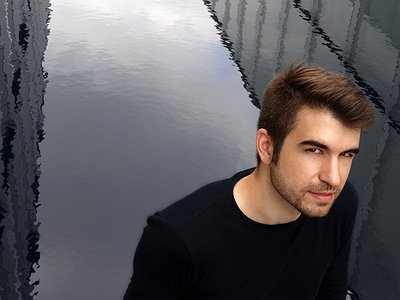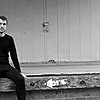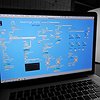Part 1
Name: John Supko
Nationality: American
Occupation: Composer
Labels: Cotton Goods, New Amsterdam
Musical Recommendations: I love Myriam Gendron's recent release Not So Deep as a Well (2014). It’s a collection of Dorothy Parker poems that Gendron has transformed into beautifully spare songs she sings and accompanies on guitar. Also released in 2014, composer Lee Weisert’s collection of electronic and electroacoustic pieces Wild Arc has been in my ears for months. It’s music that combines a deep engagement with the history of 20th century electronic music with an utterly contemporary, sensual approach to sound.
When did you start composing - and what or who were your early passions and influences?
I began composing around the age of ten in 1990, in part because I was more interested in writing my own things than in practicing for my piano lessons. Aaron Copland’s music had a powerful effect on me in childhood. I was first drawn to the famous ballets—Appalachian Spring, Billy the Kid, Rodeo—but soon discovered his earlier works from the 1920’s such as the Dance Symphony (1925), Music for the Theatre (1925), the Symphonic Ode (1929), and the wonderful Concerto for Piano & Orchestra (1926). My prized possession during this time of my life was the two-CD Copland Collection “box set” put out by Sony Classical in 1991 featuring recordings of these pieces conducted and played by Copland himself. Copland’s synthesis of experimental and accessible materials helped me to understand the music of Stravinsky, who was subsequently another early obsession. Through Copland and Stravinsky I began to explore the entire experimental landscape of the early 20th century, which remains a preoccupation for me. Much later, I would write my Princeton PhD dissertation on the music of Erik Satie.
What do you personally consider to be incisive moments in your work and/or career?
The single most incisive moment of my career was meeting my first composition teacher, Frances Thompson McKay, and subsequently studying with her for five years at the Levine School of Music in Washington, DC. I have my dedicated, non-musician parents to thank for finding her. As a successful working composer, Sis McKay’s example showed me that my private little hobby could become an important and meaningful vocation. This was a life-changing realization. Then, of course, there was the education Sis gave me: the training she passed on to me from her studies with Nadia Boulanger, the exposure to an enormous amount of music from all periods, the way she challenged my immature pandiatonicism with assignments in atonal harmony. I would have been immensely fortunate to have her as a teacher at any age, but to have been her student from the age of twelve throughout high school was immeasurably important to my development as a composer.
What are currently your main compositional challenges?
My main preoccupations relate to my interest in generative processes: how do I make a compelling piece of music that isn’t dependent on a paper score? How do I make a piece that sounds different at each performance while still sounding like itself? How do I balance variety with my desire to retain ultimate control over a piece? How much control am I willing to cede to computer processes in order to achieve a generative result? How do I get human musicians to interact with computer-based generative processes? Is there a middle ground between improvisation and composition? If the computer is generating material on the fly, does that mean that the musicians have to improvise? Is there a way for musicians to “practice” a generative piece in advance that will nonetheless produce unpredictable results in performance?
What do you usually start with when composing?
Over the past five years or so I’ve developed a series of software tools that can take musical materials – notes, rhythms, sound files, etc. – and propose starting points for a piece, which I can either accept and elaborate or reject and ask for more. I love this way of starting a new piece because it gets me outside of the limits of my own imagination and the influence of aural and muscle memory. With the computer’s help I can consider lots of possibilities I wouldn’t otherwise discover, transforming my astonishment at the machine’s strange concoctions into creative energy for the project.
How do you see the relationship between timbre and composition?
I confess that I’m baffled by how frequently I encounter questions about timbre. To my mind, it’s like asking a writer to discuss the shape of words on the page. Perhaps people talk about timbre so much because it’s so hard to say anything concrete or meaningful about it. In any case, I don’t find thinking about timbre itself exciting. I’m interested in larger issues such as how I feel time moving through a piece, or what emotional environment is created by the music I write. For me, timbre is a by-product of these macro-level issues. Sometimes my musical materials result in unusual timbres and sometimes not at all, and that’s fine with me. I would never write a piece simply to investigate timbre because that’s not enough to keep me interested. There are composers I like who write music only about music, but I try to make music the last thing my work is about.
What do improvisation and composition mean to you and what, to you, are their respective merits?
Improvisation and composition possess diametrical allures and pitfalls, and I’m equally interested in and skeptical of both. Imagination is implicitly paramount in improvisation; editing is implicitly paramount (much more so than imagination) in composition. What do I mean? Well, when has anyone expected the notes of a Beethoven string quartet to be different the second time around? When has an improviser’s performance ever been faulted for perceived defects of form?
As soon as a work is written down it is assumed that it has been edited and that care has been taken to make it “coherent.” No such assumption is made about improvisation. The editing of a composition ensures, at least to a minimal degree, that the composer’s best effort is being presented to the listener. It also ensures that the work will never change and therefore won’t offer an unpredictable listening experience. Improvisation is obviously much more treacherous. In the hands of an unskilled player, improvisation can devolve into a string of banalities, quotations, and time-filling gestures. A great improviser, however, can find ways of avoiding formulas and clichés, proceeding from surprise to surprise while nevertheless trying to keep track of the itinerary. Listening to a great improviser is one of the few ways we can witness artistic genius in real time.
I suppose I’m working to find a hybrid methodology in my work, combining aspects of improvisation and traditional composition. I’m drawn to generative processes, in part, because of my desire to capture the excitement of witnessing music come alive in the moment, much like experiencing a skilled improviser; but I also want to have ultimate control over the work, refining the generative processes so that the results will always be acceptable to me. This dichotomy creates a tension that I explore every time I write a new work.
As a composer, I want to be astonished along with the listener, as though I had never heard this music before. With a computer generating material in real time, this is in fact possible. That’s why it seems to me that carefully developed generative instructions—whether they’re computer code or text for human musicians—have exciting potential to bridge improvisation and composition. The generative instructions, that is, the information that determines what kinds of musical results can occur, are “composed” beforehand but the actual music that emerges from these instructions does so through an unpredictable, almost improvisatory, real-time process.







